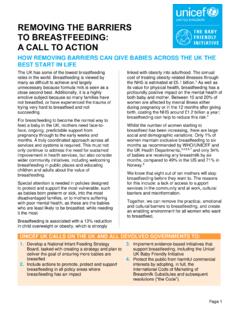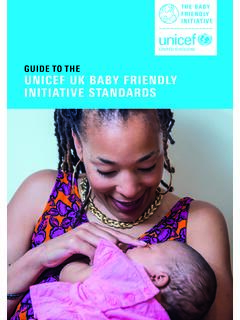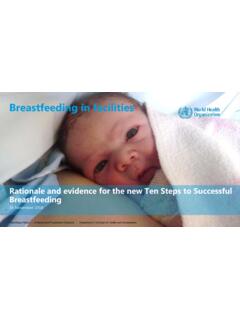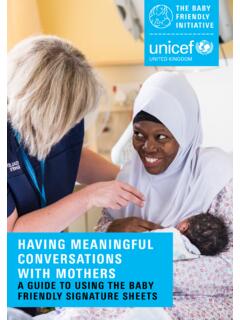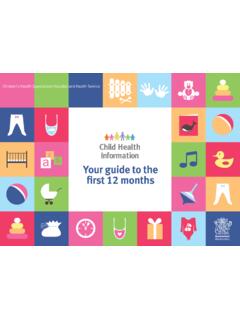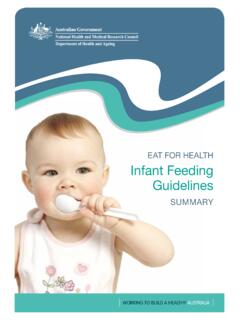Transcription of COMPLETING A BREASTFEEDING ASSESSMENT
1 OVERVIEW The Unicef UK Baby Friendly Initiative recommends that all BREASTFEEDING mothers have a formal BREASTFEEDING ASSESSMENT as often as required. At a minimum, this should be carried out at least twice in the first week of life and also during the new birth visit at around 10 days. Further assessments should take place as required in response to any BREASTFEEDING challenges. The aim of the ASSESSMENT is to look at effective BREASTFEEDING , the wellbeing of the mother and baby and to implement appropriate actions in relation to the often worry that their baby may not be getting enough milk to grow and develop. Feedback on using the ASSESSMENT tool has shown that mothers value not only reassurance but practical help to overcome challenges. This will support her to have the confidence in herself and in her baby s ability to breastfeed effectively and to know what to look out for with future feeds. The most effective way to carry out a BREASTFEEDING ASSESSMENT is to listen to the mother s story and watch the baby breastfeed.
2 At the moment, because of the coronavirus (Covid-19) outbreak, mothers may not be able to attend a face-to-face consultation for a feeding ASSESSMENT . We have therefore developed guidance on how to plan and carry out a virtual conversation how to plan and carry out a virtual conversation with motherswith mothers. There is also a suite of guidance sheets on overcoming challenges overcoming challenges, which may be useful to reference before you start. This information should be read alongside the supporting effective BREASTFEEDING supporting effective BREASTFEEDING education refresher sheeteducation refresher sheet. The following sections describe the ASSESSMENT criteria in of feeds Healthy newborn babies may feed infrequently (3-4 feeds) in the first 24 hours after birth and are able to access fat stores to protect themselves if they do not feed. However, it is important for a mother s milk supply that the baby has an opportunity to feed by being close to the mother and having prolonged skin-to-skin contact and time at the breast.
3 Babies start to feed more frequently after the first 24 hours, which helps switch on the milk producing cells. Babies are expected to have a minimum of eight feeds in 24 hours from this time onwards, although most will have more. Feeding behaviour When babies are feeding well, they are generally calm and relaxed on the breast. A baby may not be effectively positioned or attached if he is coming off and on or trying to change position. It is worth asking the mother if this happens at every feed or just occasionally to determine a cause. Babies should also be generally calm and relaxed after a feed, so asking the mother about feeds throughout the day may also be helpful as it is normal for babies to have periods of cluster feeding for food and patterns When observing a feed, particular attention should be given to changes in the pattern of sucking and swallowing. From around day three onwards, when a baby first attaches to the breast, he will often have a short period of rapid sucks.
4 These are used to release oxytocin and let down the milk. The baby s sucking pattern then changes to deep, rhythmic sucks as the ducts fill with milk. This accompanies a period of active feeding, with 1-2 sucks to a swallow. He may also have frequent rest periods during this active feeding the milk volume decreases and becomes richer in fat, the baby s sucking pattern may change to more of a quiver as he moves the fat-rich milk down the ducts. If a feed cannot be observed, careful communication is required to elicit this information and understanding of the suck/swallow ratio to ensure effective milk transfer is happening and the mother feels of feeds The great thing about BREASTFEEDING is that babies can decide for themselves how often they feed and the amount to take at each feed. Encouraging a mother to watch her baby s feeds over a 24-hour period will helpCOMPLETING A BREASTFEEDING ASSESSMENT EDUCATION REFRESHER PACK DURING THE CORONAVIRUS OUTBREAK: SHEET 7 These brief education refresher sheets are designed for staff as a teaching aid during the coronavirus outbreak.
5 Staff may include return to practice midwives or health visitors, students who have been fast-tracked to practice or health care assistants who have been redeployed into postnatal care within hospital or community settings. This information is an interim measure to help staff provide support and does not replace training. The links and information provided can be used by staff and shared with UK BABY FRIENDLY INITIATIVE: COMPLETING A BREASTFEEDING ASSESSMENTIMPORTANTIf there are concerns that the baby is not showing feeding cues and/or not waking for feeds, is sleepy or lethargic, is not actively sucking or there has been a change in feeding behaviour after a period of feeding well, then an urgent review is required and a referral should be made in accordance with trust UK BABY FRIENDLY INITIATIVE: COMPLETING A BREASTFEEDING ASSESSMENTher recognise the different patterns. The baby will decide when he has had enough and will come off the breast by himself. If every feed is short (lasting only five minutes), long (around an hour) or the baby never comes off the breast spontaneously, it is important to review positioning and attachment in more detail with the colour Babies should have normal skin colour and any deviations should prompt an appropriate referral.
6 Regarding jaundice, frequent feeds of colostrum in the early days help the baby clear the meconium out of the gut. This helps prevent reabsorption of bilirubin which can increase the risk and severity of physiological jaundice. If a baby has the first signs of jaundice at the BREASTFEEDING ASSESSMENT , then he should be reviewed and either a biliflash or a serum bilirubin should be taken (depending on local arrangements) within six hours. If jaundice first appears at less than 24 hours of age, an urgent admission to a neonatal or paediatric unit should be arranged (depending on local arrangements) within two hours. A visual ASSESSMENT of jaundice should never be used to estimate bilirubin the baby has previously been diagnosed with jaundice, then an ASSESSMENT needs to be made as to whether it is resolving. This will include previous tests done and treatment thresholds. If there is any doubt, then a referral for biliflash or serum bilirubin should be made. For additional information on jaundice, see the following link: In the first week of life, any weight loss weight loss greater than 7 percent may be an indication of possible insufficient milk intake.
7 If a baby has a 10 percent loss, then local guidelines should be followed to resolve feeding issues and ensure that the baby is not ill or becoming ill. Weight ASSESSMENT is a diagnostic tool and a useful safety net for determining whether a baby is receiving sufficient milk intake. However, it is a later sign. Urine and stool output, unresolved jaundice and lethargy provide earlier alerts to feeding and stool output Baby s urine and stooling pattern (after day three and before four to six weeks) should be a minimum of two soft, yellow stools daily. Wet nappies should increase daily until day five when there should be a minimum of six heavy, wet nappies. This is the best indicator to inform on how feeding has been over the last 24 hours. If a baby s output is less than expected, then positioning and attachment should be revisited with special attention to suck/swallow pattern which allows an immediate ASSESSMENT of milk transfer. Weight loss will become a problem in the following days if reduced output is not addressed.
8 Follow local guidelines and agree a plan with the mother. A follow up call should be arranged for the next day to ensure the plan is working and output has increased. If there are no specific trust guidelines, seek help from an experienced colleague or the infant feeding team before implementing a plan. The mother s breasts BREASTFEEDING should feel comfortable and any pain in the pain in the mother s breastsmother s breasts or nipplesnipples should be discussed and an appropriate referral made according to trust guidelines. When the baby finishes the feed and comes off the breast spontaneously, the mother s nipple should look round and not it is misshapen, revisit positioning and attachmentrevisit positioning and attachment to enable the baby to take the breast so the nipple is not compressed on the hard palate but is kept safe at the junction between the hard and soft , nipple shields and infant formula Dummies can have a profound effect when babies are starting to breastfeed.
9 Dummies have the additional risk of reducing frequency of feeds and therefore may interfere with the establishment of lactation . Mothers use dummies for a variety of reasons, so listening and exploring when they are being used may allow for an opportunity to gently discuss the possible effects and enable the mother to consider avoiding or minimising dummy use while she is establishing BREASTFEEDING . Nipple shields can also impact BREASTFEEDING , but may be useful to overcome very specific challenges and so should be used with caution. See Guidance Sheet 5F: Tongue-tieGuidance Sheet 5F: Tongue-tie for further guidance. If infant formula has been introduced, refer the mother to online resources and provide gentle guidance on maximising breastmilk and re-lactationmaximising breastmilk and re- lactation and mother can offer her breast for a variety of reasons, whether her baby is distressed, fractious or just wants to be near her. She can also offer a quick feed to buy time if she needs to go to the shop or perhaps just wants to sit down, rest and have a cuddle with her baby.
10 Breastfeeds can be long or short and it is important that mothers are aware that their breastfed baby cannot be overfed or spoiled by too much feeding. USEFUL INFORMATION
